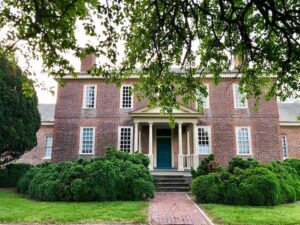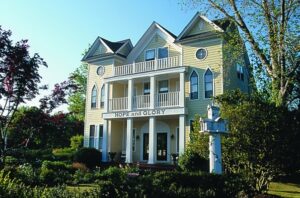The Northern Neck and Middle Peninsula of Virginia, where members of the Chesapeake Bay Wine Trail are located, is rich in history. As kids head back to school, we invite our guests to learn more about places to visit along the Trail–where the past comes alive!
Step back in time to the Northern Neck National Heritage Area, “where the Potomac and Rappahannock Rivers meet the Chesapeake Bay”. Encompassing the five Virginia counties of King George, Lancaster, Northumberland, Richmond, and Westmoreland, the Northern Neck is home to eight of Chesapeake Bay Wine Trail’s nine members: (Caret Cellars is located across the Rappahannock River, on the Middle Peninsula.)
Historic Homes, Buildings and Farms on the Chesapeake Bay Wine Trail
Several Trail wineries have historic homes and buildings that winery owners have lovingly restored to their former glory. Many are available for onsite lodging, with views overlooking the vineyards.

The first farmhouse on the land that is now Ditchley Cider Works & Farm was built around 1688 by Hancock and Mary Lee. The Lees are buried in the Ditchley cemetery several hundred yards south of the existing manor house. The Manor House was constructed by the Lee’s grandson circa 1752, and is listed on the National and State Register of Historic Places. Extensive renovations were made to the Manor House over the years, as well as the addition of a caretakers house/servants quarters in the 1930s (now the “Cider House”), a beachside “kit house” in the 50s, and other changes. The Manor House, Cider House, and grounds are available to rent for special occasions and overnight accommodations are available in both houses to support group events.
Ingleside Vineyards has the distinction of being recognized as a Virginia Century Farm, honoring over 100 consecutive years of farm operation. Built in 1834, Ingleside first served as a boys’ school known as Washington Academy. During the Civil War, it was used as a garrison for Union troops and later a courthouse. Since 1890, the Flemer family has owned and operated this historic estate and for the first fifty years, it functioned as a dairy farm. The estate evolved into a wholesale nursery and later added a vineyard after stumbling upon the fact that its location and conditions are prime for growing high-quality wine grapes. A pioneer of the modern wine industry in Virginia, Ingleside is one of the oldest wineries in the Commonwealth and was the first in the Northern Neck.
Originally built in the mid 1800’s, the renovated Manor House at General’s Ridge Vineyard invites overnight guests to step back in time to a world of peace and beauty. Nestled on secluded grounds, the huge wraparound porch and balcony of the house allows for striking views of the sun rising over the vineyard. The three-bedroom, two-bath home sleeps six, and has a full kitchen and dining area.

Only four families have owned the land upon which Rivah Vineyards at the Grove is founded. Built in 1832, the present, ancestral home of the present owners was one of very few brick houses in the county that was on the water. The old kitchen building with its huge chimney is next to the house. A 1799 deed documenting the sale of the property from Daniel Crabb to Stephen Bailey notes “Burial ground reserved,” though, to date, it has not been located.
The Dog and Oyster is located on the grounds of The Hope & Glory Inn, a former schoolhouse built in 1889. (In the 40s, the property was used as a rooming house called King Carter Inn.) Owners Dudley and Peggy Patteson have maintained the charm and character of the Chesapeake Male and Female Academy, even naming rooms in the boutique inn in honor of the old school. Guests can play Hooky at the poolside patio dining area. Then sit in Detention, the inn’s full-service bar, to enjoy a cocktail before dinner at The Colonnade, named for the ten Doric columns that frame the fine dining restaurant.
Historic Attractions Near the Chesapeake Bay Wine Trail
Three of the first five U.S. presidents were born in the Northern Neck: George Washington, James Monroe and James Madison. Three Trail wineries are located near their birthplaces.
Monroe Bay Winery is just minutes from James Monroe Birthplace & Museum. Here you will find Birthplace Home, an exact replica of Madison’s original childhood house. The Visitors Center focuses on the life of James Monroe following the time he left his birthplace home, including discussions of his military and political life.
Just a short drive from Caret Cellars is the Historical Marker for the Birthplace for James Madison, “Father of the Constitution” and fourth president of the United States. Though the actual home in which Madison was born is no longer standing, guests can stay at Belle Grove Plantation Bed & Breakfast, built in 1791 on the same homestead.
Just a few miles from Ingleside Vineyards is George Washington Birthplace National Monument, 551 acres of land where seven generations of the Washington family lived and where George Washington was born in 1732. Gain insight into the life of George Washington and those who lived, worked, and died there via the Visitors Center, numerous outbuildings, a museum, Colonial Revival Garden, Washington family burial ground, and more.

Also in the vicinity is Stratford Hall, a National Historic Landmark and home to the Lee family, including signers of the Declaration of Independence. With Stratford’s two-thousand acres of natural and human history are The Great House, circa 1738, and other historic buildings; galleries; gardens, a grist mill and more. Stratford Hall hosts a variety of events year-round, including the annual Wine & Oyster Festival every September. Enjoy wine from Virginia wineries (including several Trail members), distilleries, local oysters, food trucks, beer, artisan booths, live music, car shows and more.
Fewer than a 30-minute drive from General’s Ridge Vineyard is National Historic Landmark Menokin, home of Francis Lightfoot Lee, a signer of the Declaration of Independence. Menokin has made headlines the last few years for The Glass House Project, the only one of its kind in North America. The reconstruction process of the historic home (“dynamic preservation”) reveals the very fabric of the ruin in its current state, with missing portions of the original house replaced with architectural glass.
The rich farming history of the rural Northern Neck is illustrated via The Northern Neck Farm Museum a short distance from Trail winery Jacey Vineyards. The museum, which helps visitors understand the unique lifestyle of agriculture and its many contributions to the nation, was born from the farm equipment collection of local farmer Luther Welch and grew into what is now a five county regional museum.
Named one of the Top Three Historic Sites in Eastern Virginia by the readers of Virginia Living Magazine, Historic Christ Church is one of the best-preserved colonial churches in the United States. Built 1732-35, it is notable for its unique Georgian design. Located in Weems, Christ Church is not far from Trail members Ditchley Cider Works & Farm, The Dog and Oyster, Good Luck Cellars, and Jacey Vineyards.
Historic Towns Along the Chesapeake Bay Wine Trail
Caret Cellars is the only Trail member located on the Middle Peninsula, off of the Rappahannock River, in the small town of Caret, in the historic county of Essex, Virginia. The nearby town of Tappahannock offers a Historic Town Walking Tour, designed to take visitors back to the 17th, 18th and 19th centuries, showcasing buildings such as Scots Arms Tavern, the oldest house in the town, built in 1680; the 1760 Customs House; St. John’s Episcopal Church, constructed in 1849; and others, all located within three blocks of one another in the central downtown area. Additionally, visitors can learn more at the county museum and tour 37 Essex County historic markers and war memorials honoring those who fought in the French and Indian Wars, Revolutionary War, War of 1812, World War I, World War II, Korean War, and Vietnam War.
Originally known as “The Crossroads” (due to its beginnings as the intersection of Indian paths), the Town of Kilmarnock, home to Trail members Good Luck Cellars and Ditchley Cider Works, was first settled in the mid 1600s. Today, Kilmarnock is the commercial hub of the Northern Neck and the largest incorporated town in Lancaster County. In addition to the restaurants, shops, art galleries, and outdoor events in its charming downtown, Kilmarnock invites history lovers to visit its museum, located in the oldest remaining house in town. The main house cottage at the Kilmarnock Inn was constructed in 1884. Named The Wilson House for the 28th U.S. President, Woodrow Wilson, it is one of eight guest cottages named for Virginia-born presidents. One of the Commonwealth’s oldest pecan trees, at over 200 years old, stands proudly here on the Inn’s grounds.
The riverfront colonial port of Kinsale, home to Trail winery Rivah Vineyards at the Grove, was–and continues to be–a major export town, first with colonial deep draft ships, shallow draft schooners, and steamboats and now with barges. Listed on the National Register of Historic Places, the Kinsale Historic District offers a walking tour that includes the Kinsale Museum, The Great House, an early-19th-century cemetery, and other historic properties. During the War of 1812, the Royal Marines Battalions raided the entrance to the Yeocomico River, which concluded with the capture of four schooners. The town was again attacked during the Civil War. A re-enactment is made each year of these invasions.

The Dog and Oyster’s hometown of Irvington, Virginia once thrived as a steamboat town during the 1890s and early 1900s, when steamboats brought goods and travelers to the area. Among the earliest settlements in Virginia, the Town has a centuries-old history and traditions of watermen working its creeks and rivers. Take a walk back in time to when steamboats provided an economic lifeline to the local residents by visiting Steamboat Era Museum, final home for the restored pilothouse of the Potomac steamer, the largest surviving remnant of the Chesapeake Bay steamboat era.
Discover more places to visit, stay and dine while visiting wineries on the Chesapeake Wine Trail on our Itineraries page.
Share This Post!
